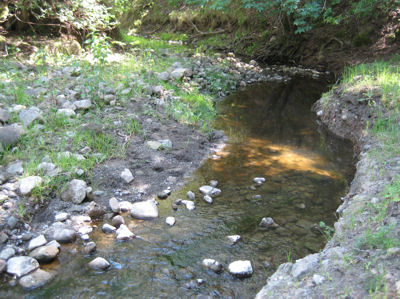

|
Home Our Activities Annual Creek Cleanup Arundo Removal Fish Sampling How to Volunteer Creeks Master Plan Creek History Maps Wildlife in the Creeks Otters and Beavers Creek Science Water Quality Bioassessment BMI Lifestyles Creek Structure Native Walnuts About FOC About Us Join Us/Donate Contact Us |
Creek StructureThere are several parts of a creek: the water flowing in it, the creek bed, and the banks. In addition to the creek itself, there's vegetation in the water, on the banks, and on the uplands immediately beyond the top of the banks. Finally, there are the animals that use the habitat. This whole assemblage is called a riparian corridor. Water FlowScientists have identified seven types of water flow in creeks. Different types of flow provide different habitats for aquatic creatures. Some use a variety of habitats for different purposes. Others are adapted to a particular type and never leave it. Types of Water Flows
Fast, slow, shallow, and deep are all relative terms. Deep is usually defined as at least half a meter. A small creek may not have any water that deep, but it probably does have spots that are deep enough to fulfill many of the functions of that habitat. Falls and cascades occur where there are rapid changes in elevation, and rapids where there is constriction of the channel. Many sample locations in Contra Costa County have little or none of these three types of flow. Falls, cascades, rapids, and riffles are important for creek health because they oxygenate the water. A healthy creek has all of the last four types of flow – riffles, runs, glides, and pools. Absence of riffles has a bigger impact on creek health than absence of one of the other types. A variety of flow types is important for the usual reason – it creates a variety of habitats which in turn promote greater biodiversity. SubstratesThe substrate is what's under the water – the creek bed. There are two general types of material found on a creek bottom, both classified by size: Classification of Substrates
Bedrock is a special case of solid rock under a creek. In addition, any of these substrates can be covered by leaf litter and other organic debris, creating yet another habitat niche. Still under construction 5/09 – more to come.
|
 Example of a fall  It's hard to tell how deep a pool is just by looking.  Riffle foreground, glide behind, and all three sizes of rocks Photos by Brad Heckman |